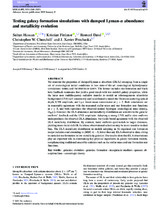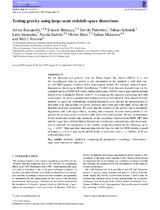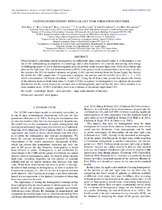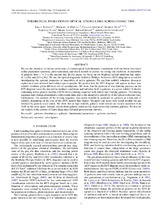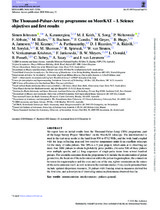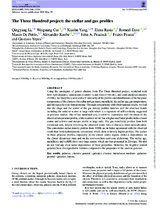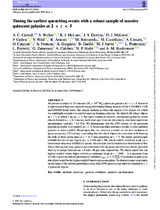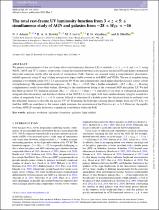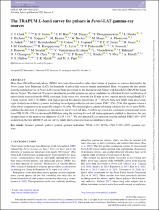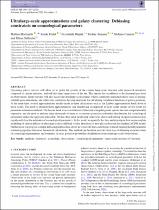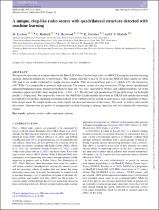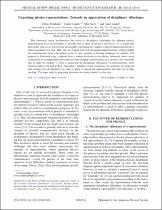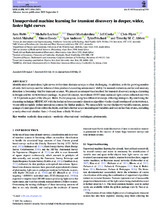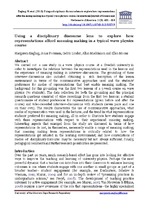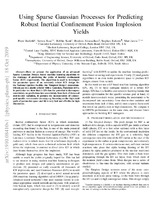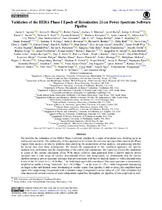Browsing Research Articles (Physics) by Title
Now showing items 475-494 of 510
-
Testing galaxy formation simulations with damped Lyman-α abundance and metallicity evolution
(Oxford University Press, 2020)We examine the properties of damped Lyman-α absorbers (DLAs) emerging from a single set of cosmological initial conditions in two state-of-the-art cosmological hydrodynamic simulations: SIMBA and TECHNICOLOR DAWN. The ... -
Testing gravity using large-scale redshift-space distortions
(Oxford University Press, 2013)We use luminous red galaxies from the Sloan Digital Sky Survey (SDSS) II to test the cosmological structure growth in two alternatives to the standard cold dark matter ( CDM)+general relativity (GR) cosmological model. ... -
Testing homegeneity with Galaxy Star formation histories
(IOP Publishing, 2013)Observationally confirming spatial homogeneity on sufficiently large cosmological scales is of importance to test one of the underpinning assumptions of cosmology, and is also imperative for correctly interpreting dark ... -
Testing the equivalence principle on cosmological scales using the odd multipoles of galaxy cross-power spectrum and bispectrum
(IOP, 2021)One of the cornerstones of general relativity is the equivalence principle. However, the validity of the equivalence principle has only been established on solar system scales for standard matter fields; this result ... -
Theoretical evolution of optical strong lines across cosmic time
(The American Astronomical Society, 2013)We use the chemical evolution predictions of cosmological hydrodynamic simulations with our latest theoretical stellar population synthesis, photoionization, and shock models to predict the strong line evolution of ... -
The thousand-pulsar-array programme on MeerKAT – I. Science objectives and first results
(Oxford University Press, 2020)We report here on initial results from the Thousand-Pulsar-Array (TPA) programme, part of the Large Survey Project ‘MeerTime’ on the MeerKAT telescope. The interferometer is used in the tied-array mode in the band from 856 ... -
The three hundred project: The stellar and gas profiles
(Oxford University Press, 2020)Using the catalogues of galaxy clusters from The Three Hundred project, modelled with both hydrodynamic simulations (GADGET-X and GADGET-MUSIC), and semi-analytical models (SAMs), we study the scatter and self-similarity ... -
Timing the earliest quenching events with a robust sample of massive quiescent galaxies at 2 < z < 5
(Oxford University Press, 2020-06-04)We present a sample of 151 massive (M∗ > 1010 M) quiescent galaxies at 2 <z< 5, based on a sophisticated Bayesian spectral energy distribution fitting analysis of the CANDELS UDS and GOODS-South fields. Our sample includes ... -
Torsion driven inflationary magnetogenesis
(American Physical Society, 2020)We show that the breaking of the conformal invariance of the electromagnetic Lagrangian, which is required for inflationary magnetogenesis, arises naturally in the Poincaré gauge theory. We use the minimal coupling ... -
The total rest-frame UV luminosity function from 3 < z < 5: a simultaneous study of agn and galaxies from −28 < MUV < −16
(Oxford University Press, 2023)We present measurements of the rest-frame ultraviolet luminosity function (LF) at redshifts z = 3, z = 4, and z = 5, using 96894, 38655, and 7571 sources, respectively, to map the transition between active galactic nuclei ... -
Trapum discovery of 13 new pulsars in ngc 1851 using meerkat
(Hans Publishers, 2022)We report the discovery of 13 new pulsars in the globular cluster NGC 1851 by the TRAPUM Large Survey Project using the MeerKAT radio telescope. The discoveries consist of six isolated millisecond pulsars (MSPs) and seven ... -
The trapum l-band survey for pulsars in fermi-lat gamma-ray sources
(Oxford University Press, 2023)More than 100 millisecond pulsars (MSPs) have been discovered in radio observations of gamma-ray sources detected by the Fermi Large Area Telescope (LAT), but hundreds of pulsar-like sources remain unidentified. Here, we ... -
Ultralarge-scale approximations and galaxy clustering: Debiasing constraints on cosmological parameters
(Oxford University Press, 2022)Upcoming galaxy surveys will allow us to probe the growth of the cosmic large-scale structure with improved sensitivity compared to current missions, and will also map larger areas of the sky. This means that in addition ... -
A unique, ring-like radio source with quadrilateral structure detected with machine learning
(Oxford University Press, 2023)We report the discovery of a unique object in the MeerKAT Galaxy Cluster Le gacy Survey (MGCLS) using the machine learning anomaly detection framework ASTRONOMALY. This strange, ring-like source is 30 from the MGCLS field ... -
Unpacking physics representations: Towards an appreciation of disciplinary affordance
(American Physical Society, 2014)This theoretical article problematizes the access to disciplinary knowledge that different physics representations have the possibility to provide; that is, their disciplinary affordances. It is argued that historically ... -
Unsupervised machine learning for transient discovery in deeper, wider, faster light curves
(Oxford University Press, 2020)Identification of anomalous light curves within time-domain surveys is often challenging. In addition, with the growing number of wide-field surveys and the volume of data produced exceeding astronomers’ ability for manual ... -
Unveiling the universe with emerging cosmological probes
(Springer, 2022)The detection of the accelerated expansion of the Universe has been one of the major breakthroughs in modern cosmology. Several cosmological probes (Cosmic Microwave Background, Supernovae Type Ia, Baryon Acoustic Oscillations) ... -
Using a disciplinary discourse lens to explore how representations afford meaning making in a typical wave physics course
(Springer Verlag, 2013)We carried out a case study in a wave physics course at a Swedish university in order to investigate the relations between the representations used in the lessons and the experience of meaning making in interview–discussions. ... -
Using sparse gaussian processes for predicting robust inertial confinement fusion implosion yields
(arXiv, 2019)Here we present the application of an advanced Sparse Gaussian Process based machine learning algorithm to the challenge of predicting the yields of inertial confinement fusion (ICF) experiments. The algorithm is used ... -
Validation of the HERA Phase I Epoch of Reionization 21 cm Power Spectrum Software Pipeline
(The American Astronomical Society., 2022)We describe the validation of the HERA Phase I software pipeline by a series of modular tests, building up to an end-to-end simulation. The philosophy of this approach is to validate the software and algorithms used in ...

